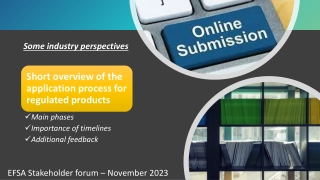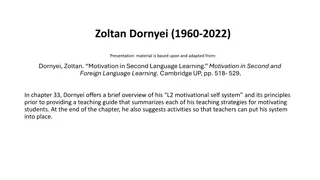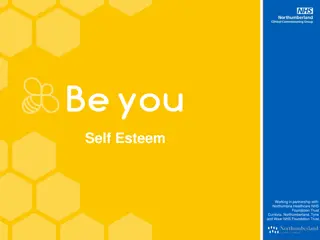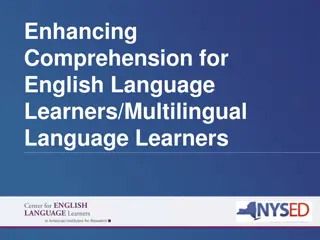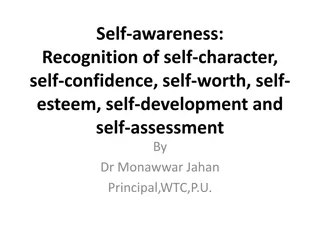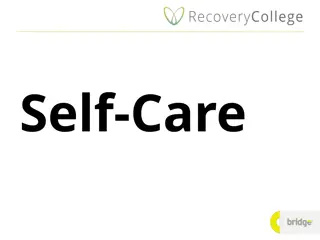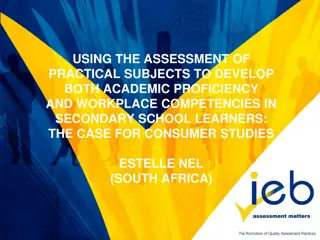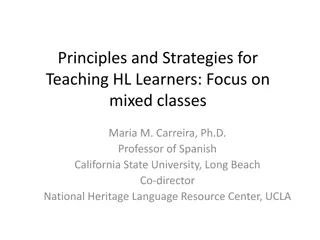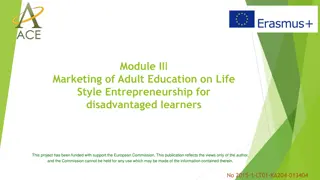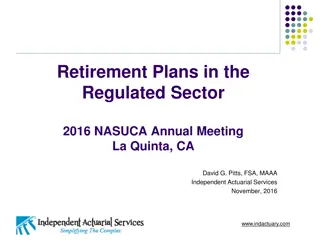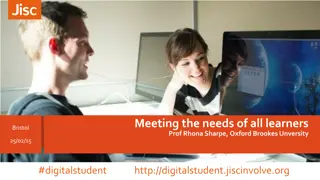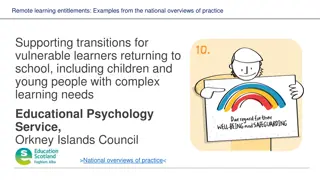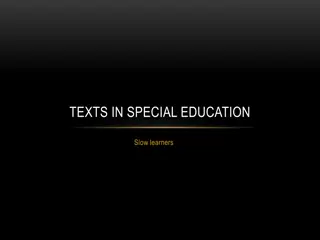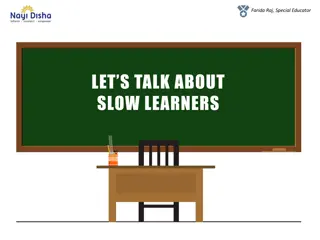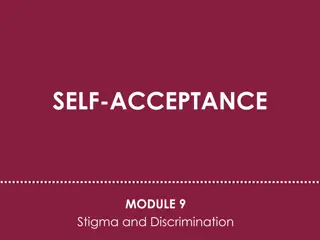Strategies for Developing Self-Regulated Learners
Understanding self-regulation is crucial for students to manage emotions, impulses, and behavior effectively. It involves developing skills like focused attention, managing emotions, delaying gratification, and more. Stress can impact brain development negatively, leading to long-term effects like smaller brain regions. By supporting the development of self-regulation skills, students can become more adaptive and goal-oriented learners.
Uploaded on Sep 26, 2024 | 2 Views
Download Presentation

Please find below an Image/Link to download the presentation.
The content on the website is provided AS IS for your information and personal use only. It may not be sold, licensed, or shared on other websites without obtaining consent from the author.If you encounter any issues during the download, it is possible that the publisher has removed the file from their server.
You are allowed to download the files provided on this website for personal or commercial use, subject to the condition that they are used lawfully. All files are the property of their respective owners.
The content on the website is provided AS IS for your information and personal use only. It may not be sold, licensed, or shared on other websites without obtaining consent from the author.
E N D
Presentation Transcript
Calming Overwhelming Emotions: STRATEGIES TO HELP STUDENTS BECOME SELF-REGULATED LEARNERS
What is self regulation? The ability to respond to the ongoing demands of experience with the range of emotions in a manner that is socially tolerable and sufficiently flexible to permit spontaneous reactions as well as the ability to delay spontaneous reactions as needed (Cole, Michel, Teti, 1994, p. 76). An individual s ability to modify an emotional state so as to promote adaptive, goal-oriented behaviors. (Shaw, Stringaris, Nigg, & Leibenluft, 2014)
What is Self-Regulation? Different aspects of it Focused attention Managing difficult and uncomfortable emotions Delaying gratification Some developmental tasks requiring emotion regulation: Tolerating frustration and tolerating being alone for reasonable periods Engaging others, developing friendships Recognizing danger, coping with anxiety and fear Defending oneself within bounds of acceptable behavior Developing interest and motivation in learning
Understanding Self-Regulation Ability to manage emotions, impulses and behavior Suggests flexibility and adaptability Dependent on environmental and contextual supports Biology, Genetics, & Temperament Self-regulation skills that develop over time Motivation to self-regulate Caregiver support by modeling, teaching, and coaching Environmental context
Set of Skills that can be developed Working memory Inhibitory control Cognitive flexibility Attention Things that can be isolated and strengthened
How does stress affect the developing brain? When stress response is prolonged, there will be long term impacts on the child s brain More active amygdala Smaller hippocampus Smaller frontal lobe Smaller Corpus Colosseum Reduced size of cortex
What does this mean? Frontal Lobe Functions Impulse Control Organization Time Management Understanding Social Cues Corpus Callosum Not well integrated Having problems using words to solve problems
What does this mean? Amygdala Functions Problems with emotional control Difficulty with cause and effect Not able to empathize Difficulty finding words or describing emotions Hyper-arousal = anxiety Hippocampus Functions Impaired learning Difficulty making memories or retrieving memories Impulsiveness
Resulting in problems at school School age children experience changes in brain regions that normally would help: Manage fears, anxieties or aggression Sustain attention Control impulses Manage physical responses to danger
Implicit Memories Often Direct Behavior Pre-verbal experiences Stored in implicit memory Activated by experiences Emotional response to current events filtered by past events Such as: Reactions to authority Power Struggles Attention Seeking Behavior
For example: At six months old get bitten by dog on the hand At 2 years old get bitten again by dog on hand When see a dog: Feeling of fear Feeling of pain in my hand Barking sound And feeling that want to run
How do we learn to self-regulate It is something that we can learn Co-regulation Baby hears loud noise By looking at mom s face, draws attention away from the noise Also has a soothing quality because Mom does not show signs of stress Need for self-soothing behaviors such as thumb sucking Reduce distress and frustration Re-focus attention
How do we learn to self-regulate Speaking in calm tones Modeling self-calming strategies Talking children through strategies when they are upset Use of words to express emotions Modeling conflict resolution skills Learning selective attention Perspective taking
Developing self-regulation Develops over time from birth to young adulthood Early childhood & adolescence are times where self-regulation skills peak due to changes in brain architecture Skills can be strengthened and taught from caregivers Repeated practice in supportive context Develops in context of social relationships Dependent on co-regulation by parents or other adults
Process Regulating Emotions Identification of internal emotions Understanding different feeling states Applying appropriate labels ( Happy or Sad ) Express emotions safely and regulate internal experience Impaired ability to self-soothe Dissociation Numbing of experiences Avoiding uncomfortable or overwhelming emotions Feeling uneasy
If unable to regulate emotions Develop emotional instability Quick responses to minor stressors Extremely rapid escalation of emotional response
Managing Stress Manageable stress builds coping skills Prolonged stress and adversity can disrupt the development of self- regulation Overwhelm child s skills or supports Negatively impact development Creates long-term changes in neurobiology Situations such as: Poverty Trauma Homelessness
Individual responses to stress Individuals vary in responses to adverse experiences Genetics and Environment Protective factors Coping skills Experiencing repeated stressors may make it difficult to self-regulate when faced with stress later Neurobiological changes
Responses to stress Internalized responses Depression Anxiety Dissociation Externalizing Impulsivity Disruptive behaviors Aggression
Understanding dissociation Coping mechanism to deal with trauma Allows separation from experiences Normal response to overwhelming circumstances Spacing out Driving on autopilot Getting lost in a book or movie Being in the zone Ability to shift focus Can become an automatic response to stress
Normal dissociation Child becomes absorbed in an activity and is unaware of what is happening around them Child develops a make believe world Knows the difference between fantasy and real Child reads to end of the page and does not remember what they read Mind went somewhere else Child can block out something unpleasant without harming overall functioning
Problematic Dissociation Zoning out and not listening to teacher without having control over behavior This can interfere with overall learning Depersonalization Feeling disconnected from self Blocking out other senses as well Derealization Need to separate conscious awareness from terrifying event Feeling that surroundings are unfamiliar or unreal Feeling foggy or feeling like I m in a movie
Dissociation resembles other diagnosis ADHD: difficulty focusing on tasks ODD: Explosive and aggressive outbursts Bi-polar disorder: frequent mood shifts Tyler, Cauce & Whitbeck (2004) found that dissociative behavior is widespread among homeless and runaway youth
Externalizing with Behaviors Attempts to overcontrol or under control certain behaviors Trouble controlling and expressing emotions May react inappropriately to situations May show violent reactions Want to control and not change routines
Protective Factors Positive connection to adults within family or community Development of self regulation activities Positive self-concept Desire to act effectively in one s environment Developing an internal locus of control Valuing their knowledge and story Helping them to see themselves as active agents versus passive victims Engaging youth Actively listening to their stories
Body can help us learn emotions Teaching children to read body signals What are the cues that my body gives me? Where do I feel it in my body? Are my muscles tighter? What s going through my mind? Has the volume of my voice changed? Am I speaking any faster/slower?
Ways to support self-regulation Provide labels for emotions Demonstrate self-talk to calm down Demonstrate taking deep breaths Prompt child to follow Reinforce them for responding Explaining rules Talk through problems or difficult situations Delaying gratification
Interventions Elementary School Teach problem-solving Model conflict resolution Provide time, space and support to manage emotions Model, prompt, and reinforce organization and time management skills Monitor task completion while encouraging independence and providing external consequences as needed http://fpg.unc.edu/sites/fpg.unc.edu/files/resources/reports-and-policy-briefs/SelfRegulationReport4.pdf
Strategies for Middle School Monitor and reinforce task completion Coach organization skills Teach planning and prioritization Collaboratively problem solve social and academic issues Coach healthy stress management Encourage decision-making when less emotional Reduce emotional intensity of interactions and situations exceeding coping skills http://fpg.unc.edu/sites/fpg.unc.edu/files/resources/reports-and-policy-briefs/SelfRegulationReport4.pdf
Learning to focus Help them focus on finishing a portion of the project rather than the entire thing Teach strategies to help them attain the goal Set aside time (15 minutes) to work without distraction Self-reflect on what worked and what didn t work What contributed to successes What could do differently next time
Mindfulness Paying attention in specific way Being in the present Helps with emotional regulation capacity Helps to bring one s thoughts and feelings to the present moment Focusing and directing attention to specific areas Taps into connections between mind and body
How can mindfulness help? Enhance focus Reduce attention problems Improve wellbeing Increase social skills Reduce anxiety or distress Reduce impulsivity and reactivity Bring greater calmness and awareness Improve cognitive performance
Mindfulness for children Emotional Mind: recognize emotions that are present Reasonable Mind: recognize thinking errors Wise mind: Understand the ebb and flow of negative/positive thinking
Some Mindful activities Superman pose Wonder Woman pose Activate your Spidey senses Creating a mindful jar with glitter Blowing bubbles or Mindful Breath Use of a tool such as a chime or bell Listen until you can no longer hear it Focus your attention on breathing Check your weather report Describe feelings in a particular moment
Neuroplasticity The brain is constantly rewiring itself Neurons that wire together fire together Constantly making new patterns
References Ackerman, C. (2017). Mindfulness activities for children and teens: 25 Fun exercises for kids. Retrieved from https://positivepsychologyprogram.com/mindfulness-for-children-kids-activities/ Barnes, A.J., Lafavor, T.L., Cutuli, J.J., Zhang, L., Oberg, C.N., & Masten, A.S. (2017). Health and self-regulation among school-aged children experiencing family homelessness. Children: 4:70. Cole, P.M., Michel, M.K., & Teti, L.O. (1994). The development of emotion regulation and dysregulation: A clinical perspective. The Development of emotion regulation: Biological and Behavioral Considerations.Monograph of the Society for Research in Child Development: 59, 2/3: 73-100. Cook, A., Spinazzola, J., Ford, J., Lanktree, C., Blaustein, M., Cloitre, M., van der Kolk, B. (2005). Complex trauma in children and adolescents. Psychiatric Annals: 35: 390-398. Herbers, J.E., Cutuli, J.J., Monn, A.R., Narayan, A.J., & Masten, A. (2014). Trauma, adversity and parent-child relationships among children experiencing homelessness. Journal of Abnormal Psychology: 42: 1167-1174. MacDonald, S. (2014). Managing risk: Self-regulation among homeless youth. Child Adolescent Social Work Jornal, 31: 497-520. Shaw, P., Stringaris, A., Nigg, J., Leibenluft, E., Emotion dysregulation in attention deficit hyperactivity disorder. American Journal of Psychiatry, 171:3. March 2014. Tyler, K.A., Cauce, A.M., & Whitbeck, L. (2004). Family risk factors and prevalence of dissociative symptoms among homeless and runaway youth. Child Abuse & Neglect: 28: 355-366.


